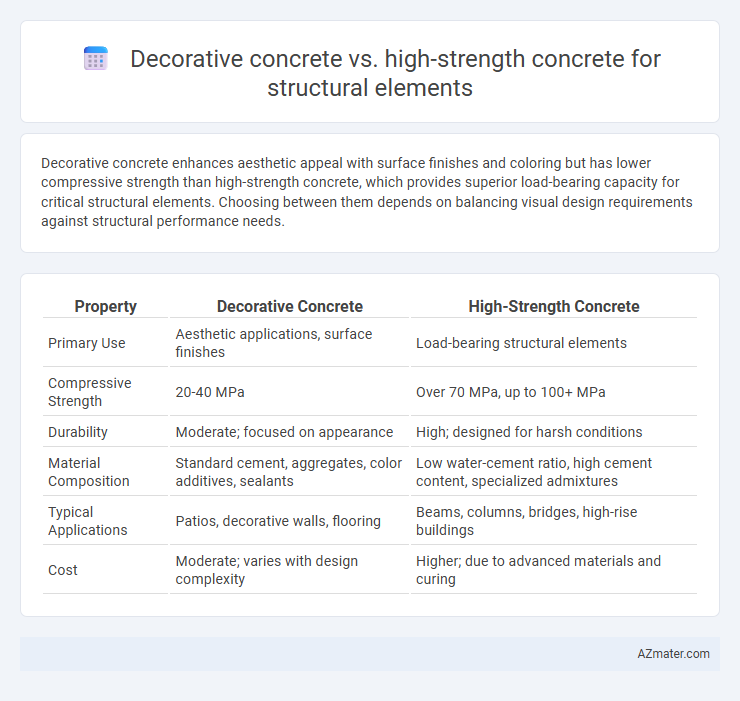Decorative concrete enhances aesthetic appeal with surface finishes and coloring but has lower compressive strength than high-strength concrete, which provides superior load-bearing capacity for critical structural elements. Choosing between them depends on balancing visual design requirements against structural performance needs.
Table of Comparison
| Property | Decorative Concrete | High-Strength Concrete |
|---|---|---|
| Primary Use | Aesthetic applications, surface finishes | Load-bearing structural elements |
| Compressive Strength | 20-40 MPa | Over 70 MPa, up to 100+ MPa |
| Durability | Moderate; focused on appearance | High; designed for harsh conditions |
| Material Composition | Standard cement, aggregates, color additives, sealants | Low water-cement ratio, high cement content, specialized admixtures |
| Typical Applications | Patios, decorative walls, flooring | Beams, columns, bridges, high-rise buildings |
| Cost | Moderate; varies with design complexity | Higher; due to advanced materials and curing |
Introduction to Decorative and High-Strength Concrete
Decorative concrete enhances aesthetic appeal by incorporating pigments, textures, and finishes, making it ideal for visually prominent structural elements. High-strength concrete, characterized by compressive strengths exceeding 6,000 psi, is engineered for durability and load-bearing capacity in critical structural components. Understanding the distinct purposes and material properties of both types guides optimal selection in architectural and structural design projects.
Key Properties of Decorative Concrete
Decorative concrete emphasizes aesthetics with properties such as customizable colors, textures, and patterns, while maintaining basic durability and moderate compressive strength suited for non-load-bearing structural elements. It offers superior surface finish and resistance to weathering, making it ideal for exposed architectural features but not for critical load demands. High-strength concrete, in contrast, prioritizes compressive strength above 6000 psi for load-bearing applications but lacks the ornamental versatility found in decorative concrete.
Performance Characteristics of High-Strength Concrete
High-strength concrete exhibits superior compressive strength exceeding 6000 psi, making it ideal for structural elements subjected to heavy loads and high stress. Its enhanced durability and reduced permeability improve resistance to environmental factors such as freeze-thaw cycles, chemical attack, and corrosion of reinforcement. Unlike decorative concrete, which prioritizes aesthetics and surface finish, high-strength concrete focuses on mechanical performance, structural integrity, and long-term reliability in construction applications.
Aesthetic Considerations in Structural Concrete
Decorative concrete enhances structural elements by incorporating pigments, textures, and patterns, elevating visual appeal without compromising functionality, making it ideal for exposed architectural features. High-strength concrete focuses primarily on durability and load-bearing capacity, often exhibiting a uniform, plain appearance that may require additional finishing for aesthetic purposes. Balancing aesthetic considerations with structural demands, decorative concrete enables designers to achieve visually striking elements, while high-strength concrete ensures safety and longevity in critical load-bearing applications.
Structural Applications: Where Strength Takes Priority
High-strength concrete is engineered to meet critical structural demands, providing superior compressive strength typically above 6,000 psi, making it ideal for load-bearing columns, beams, and foundations where durability and safety are paramount. Decorative concrete, while enhancing aesthetic appeal through surface treatments and color integration, generally lacks the extreme structural properties required for heavy-load applications and is best suited for facade elements or non-load-bearing surfaces. For structural elements where performance and longevity under stress are crucial, high-strength concrete remains the optimal choice due to its robust mechanical properties and proven reliability in infrastructure projects.
Durability and Longevity Comparisons
High-strength concrete offers superior durability and longevity for structural elements due to its enhanced compressive strength, reduced permeability, and improved resistance to environmental stressors such as freeze-thaw cycles and chemical attacks. Decorative concrete, while aesthetically versatile with various finishes and colors, typically lacks the same level of structural performance and may require additional treatments or sealants to maintain durability over time. In applications where structural integrity and extended service life are critical, high-strength concrete remains the preferred choice for ensuring resilience and reduced maintenance.
Cost Implications for Construction Projects
Decorative concrete typically incurs lower upfront costs due to simpler materials and aesthetic-focused finishes, making it suitable for non-load-bearing applications, whereas high-strength concrete demands higher initial investment driven by advanced mix designs and material quality to ensure structural integrity. Construction projects prioritizing durability and load capacity will face increased expenses with high-strength concrete, including specialized labor and longer curing times, impacting overall budget and timeline. Cost implications vary substantially based on project requirements, balancing aesthetic value against structural performance and long-term maintenance needs.
Maintenance Requirements and Life Cycle
Decorative concrete typically requires more frequent maintenance due to its aesthetic coatings and surface treatments, which can wear or fade over time from exposure to weather and foot traffic. High-strength concrete, designed for structural performance, offers enhanced durability and requires less frequent maintenance, contributing to a longer life cycle in load-bearing applications. The life cycle cost of high-strength concrete is generally lower when considering repairs and maintenance, whereas decorative concrete demands periodic upkeep to preserve its visual appeal.
Environmental Impact and Sustainability
Decorative concrete often uses standard cement mixes with added pigments and surface treatments, which may incorporate recycled materials but typically requires more maintenance, potentially increasing its environmental footprint over time. High-strength concrete, designed with optimized cementitious content and supplementary materials like fly ash or slag, offers enhanced durability and reduced material consumption, contributing to lower carbon emissions and longer service life in structural elements. Utilizing high-strength concrete improves sustainability by minimizing resource use and extending the lifespan of infrastructure, whereas decorative concrete focuses more on aesthetics with variable environmental trade-offs depending on maintenance needs.
Choosing the Right Concrete for Your Structural Needs
High-strength concrete, typically exceeding 6,000 psi, is engineered for load-bearing structural elements requiring superior durability and resistance to stress, making it ideal for foundations, beams, and columns. Decorative concrete emphasizes aesthetics with textures, colors, and patterns, often used in non-structural applications such as flooring, facades, and landscaping rather than critical load-bearing components. Selecting the right concrete involves evaluating performance requirements, where structural integrity mandates high-strength concrete while visual appeal preferences guide the use of decorative options.

Infographic: Decorative concrete vs High-strength concrete for Structural element
 azmater.com
azmater.com